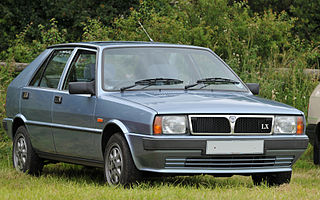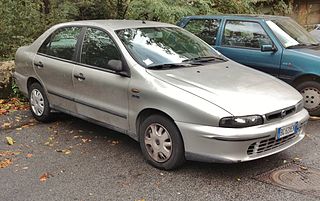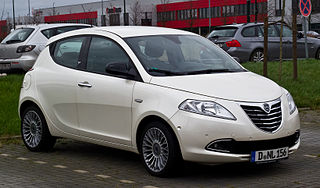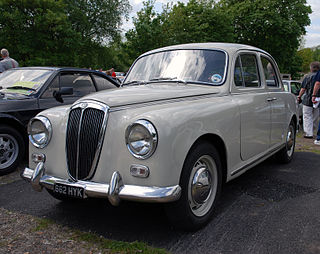
The Lancia Delta is a small family car produced by Italian automobile manufacturer Lancia in three generations. The first generation (1979-1994) debuted at the 1979 Frankfurt Motor Show, the second generation (1993-1999) debuted at the 1993 Geneva Motor Show, and the third generation (2008-2014) debuted at 2008 Geneva Motor Show.

The Lancia Stratos HF, widely and more known simply as Lancia Stratos, is a sports car and rally car made by Italian car manufacturer Lancia. The HF stands for High Fidelity. It was a very successful rally car, winning the World Rally Championship in 1974, 1975 and 1976; and race car winning 1974 Targa Florio, five times the Tour de France Automobile and three editions of Giro d'Italia automobilistico.

The Lancia Thema is an executive car produced by the Italian automaker Lancia between 1984 and 1994, and one of four cars to share the Type Four platform alongside the Alfa Romeo 164, Fiat Croma and Saab 9000. The Thema was first shown in Turin Motor Show in 1984.

The Alfa Romeo 164 is a four-door executive saloon manufactured and marketed by Italian automaker Alfa Romeo from 1987-1998, styled by Pininfarina, and cooperatively designed and sharing platforms and numerous elements with the Fiat Croma, Saab 9000 and Lancia Thema. The predecessors of the 164 were the Alfa 90 and the luxurious Alfa 6. The 164 was superseded by the 166 in 1998, after a combined production total of 273,857 units.

The Fiat Marea is a small family car available as a saloon and an estate, produced by the Italian automaker Fiat. Launched in September 1996, the Marea models were essentially different body styles of Fiat's hatchback offerings, the Bravo and Brava. The Marea replaced the earlier Tipo based Fiat Tempra, as well as the larger Croma.

The Lancia Fulvia is an automobile produced by Lancia between 1963 and 1976. Named after Via Fulvia, the Roman road leading from Tortona to Turin, it was introduced at the Geneva Motor Show in 1963 and manufactured in three variants: Berlina 4-door saloon, 2-door Coupé, and Sport, an alternative fastback coupé designed and built by Zagato on the Coupé floorpan.

The Lancia Montecarlo is a Pininfarina-designed mid-engined sports car produced by Lancia in Italy from 1975 to 1981.

The Lancia Rally was a mid-engine sports car and rally car built by Lancia in the early 1980s to compete in the FIA Group B World Rally Championship. Driven by Markku Alén, Attilio Bettega, and Walter Röhrl, the car won Lancia the manufacturers' world championship in the 1983 season. It was the last rear-wheel drive car to win the WRC.

The Lancia Beta was an entry-level luxury car produced by Italian car manufacturer Lancia from 1972 to 1984. It was the first new model introduced by Lancia after it had been taken over by Fiat in 1969.

The Lancia Ypsilon is a supermini manufactured and marketed by Lancia, now in its third generation and as of 2022, the marque's only model. The Ypsilon was released in 1995, as a larger and more expensive replacement to the Y10. Between 1995 and 2005 Lancia produced more than 870,000 Ypsilons in the Melfi plant in the Potenza region.

The Lancia Dedra is a compact executive car produced by the Italian automaker Lancia from 1989 to 1999. It was initially designed to support, and later to replace, the Prisma that, six years after its launch, was having difficulty remaining competitive with its latest opponents. It can be considered as the saloon version of the second generation Delta, that was launched four years later, in 1993.

The Lancia Musa is a front-engine, front-wheel-drive, five-door, five-passenger high roof B-segment mini MPV manufactured by Fiat, and marketed by the company's Lancia subdivision for model years 2004 through to 2012. As a modified variant of the Fiat Idea, the Musa also employs the Project 188 platform, originally used for the second generation Fiat Punto.

Executive car is a British term for a large car which is equivalent to the European E-segment and American full-size classifications. Executive cars are larger than compact executive cars, and smaller than luxury saloons / full-size luxury sedans.

The Lancia Kappa or Lancia k is a front-engine, front-drive, four-door, five passenger, left-hand drive executive sedan manufactured and marketed by Italian automaker Lancia from 1994–2000, with estate and coupé variants — sharing platforms with the Alfa Romeo 166.

A compact executive car or a compact luxury car is a premium car larger than a premium compact and smaller than an executive car. Compact executive car is a UK term and a part of the D-segment in the European car classification.

The Lancia Appia is a passenger car introduced in 1953 by Italian car manufacturer Lancia as a replacement for the Ardea, and which remained in production for ten years. The Appia was the last in a long line of Lancia production cars dating back to the Lancia Lambda to use sliding pillar front suspension. All three series produced had a 1089cc Lancia V4 engine.

The Lancia Alfa 12 HP was the first car made by Lancia.

The Lancia 20 HP, later renamed Lancia Gamma, is a passenger car produced by the Italian car manufacturer Lancia during 1910. It was derived from a previous Beta model, now equipped with a bigger engine. In total, 258 units were built. In 1911, the type was superseded by the larger-engined and more powerful Lancia 20-30 HP Delta.
The Lancia 20-30 HP, later renamed Lancia Delta, is a passenger car produced by Italian car manufacturer Lancia during 1911. The Delta was based on the earlier 20 HP Gamma, with an enlarged engine. 303 Deltas were made in total, before it was replaced by the improved 20-30 HP Epsilon.

Vittorio Jano designed a new 60° V12 engine for sports car racing for Ferrari. This new engine, introduced in 1956, combined elements of both Colombo and Lampredi engines with new features. Engine architecture was more of Lampredi school but retained smaller Colombo internal measurements. Jano moved to Ferrari along with his designs for the Lancia D50 in 1955 and went on to design not only a new V12 but also a family of the Dino V6 engines soon after. Some of the technical ideas came from the Jano's Lancia V8 DOHC engine, intended for Formula One. This family of engines replaced Lampredi inline-4s known from Ferrari Monza line and went on to win many international races and titles for Ferrari. The design team comprised Jano as well as Vittorio Bellentani, Alberto Massimino, and Andrea Fraschetti.



















